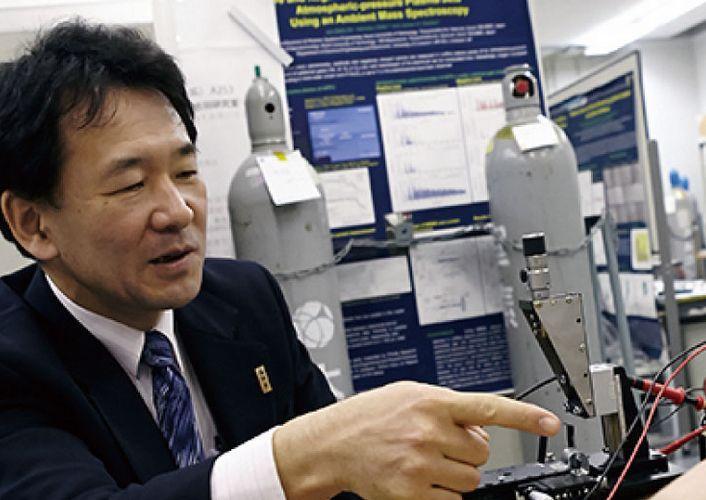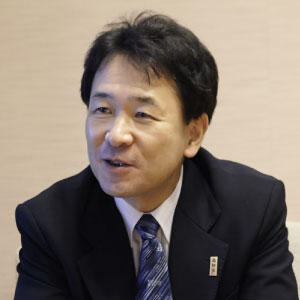- TOP
- Cutting-edge Research and Social Contribution
- Cutting-edge Research
- World-first ultra-high precision measurement technology: Clarifying the plasma irradiated water reaction

World-first ultra-high precision measurement technology: Clarifying the plasma irradiated water reaction

HATTA Akimitsu
- Specialized field
Plasma science and engineering, electric and electronic material, energy and environmental education
Plasma, opening up possibilities in every advanced field
Plasma is said to be the fourth state of matter, along with solid, liquid and gas. Research has been searching for applications of plasma in a wide range of industries, for example in familiar products such as plasma televisions and air purifiers, but the nature of plasma remains mysterious. Professor Hatta, an expert in applied plasma research, has studied plasma from many angles.
Prof. Hatta says, "The research that I am currently conducting includes the development of environmentally friendly mercury-free light sources, nanometer-sized semiconductor devices such as carbon nanotubes, the production of artificial diamond, which is expected to be a super high performance material, and medical uses of plasma. My research on plasma is expanding across a variety of genres. Plasma is very flexible in terms of the range of its applications."
About 70 years ago, research began work towards creation of an artificial sun (called nuclear fusion) on Earth. If realized, that dream technology would lead to dramatic solutions to energy problems. Prof. Hatta was completely absorbed in plasma research during his college years. He was a member of a laboratory that was working on this concept, which could be humanity's future energy source.
Prof. Hatta explains, "Without the research objective of nuclear fusion, I believe that plasma research would not have become so popular. In the work towards using plasma as an energy source, the road has been long, and has taken many twists and turns. Now all that research has yielded a variety of technologies, including superconducting materials that are used in linear motor cars.
As plasma research advances, the range of Prof. Hatta 's plasma research is expanding greatly.
Stepping daringly into unexplored fields
One of Prof. Hatta's research projects, a plasma medical treatment study conducted jointly with Kochi Medical School, is producing great results. About ten years ago, as technology was developed for the generation of plasma in the atmosphere, research on plasma irradiation of humans and plants was pursued, and the possibility of applications in advanced medical care was clear. The discovery that plasma irradiation is selective in its killing of cancer cells has attracted attention as a step towards new technology for cancer treatment.
Prof. Hatta explains, "We don't fully understand why that phenomenon happens, so it's a major task for plasma researchers to analyze that."
Most of the human body consists of water. Therefore, it is important to elucidate the mechanism of how water is irradiated with plasma, for example what kind of substance triggers germination; how that kind of substance changes under irradiation; how it dissolves in water; and how it is transported to the cells of the body.
Prof. Hatta adds, "To that end, it was a top priority to accurately measure oxygen- and nitrogen-based active compounds such as hydrogen peroxide, nitrous acid and nitric acid that are generated when water is irradiated with plasma. The measurement was quite a bit more complicated than we imagined, so it took much longer than we anticipated."
Why was it so difficult? Prof. Hatta aggressively took on an unexplored factor of the problem. He found that when water is irradiated by plasma, there is complicated behavior in the vacuum ultraviolet region of the absorption spectrum, at a wavelength of 190 to 200 nm. He discovered that at the same time as the concentration change in oxygen- and nitrogen-based active compounds, the concentration of oxygen dissolved in water changed, resulting in a change in the absorption spectrum. Although the absorption of light by oxygen at wavelengths of 200 nm or less is a well known phenomenon, it became clear that not only oxygen dissolved in gas but also oxygen dissolved in water should be taken into consideration.
Subsequently, Prof. Hatta conceived of the idea of measuring the oxygen- and nitrogen-based active compounds generated by means of absorption spectroscopy extended to the vacuum ultraviolet region. He succeeded in making very accurate measurements while taking into account the spectrum change due to dissolved oxygen in water, and thus established a new technology.
He explains, "This is the world first technology for real time analysis of the type and amount of chemical compounds generated by irradiation of the water surface at the PPM level. Accurate measurement is an important factor for elucidating the influence of plasma irradiation of water and how that mechanism affects the living body."
Prof. Hatta says he is currently conducting experiments and analysis in collaboration with the University of South Australia to determine the difference between direct plasma irradiation of water and plasma irradiation through artificial skin. The resulting data is expected to provide important knowledge towards practical applications of plasma in medical treatment.
"There are many people who will not engage with things they do not understand, but I think that is not the right attitude. There can be no real progress unless you work hard to gain an understanding of something beyond your experience. My natural inclination is to accumulate experiments one by one so as to deepen my understanding thoroughly and eventually solve a problem. I do not begin with some special preconceived idea; I just continue seriously exploring until I am convinced I have found the solution."
For the applications of plasma irradiation of water, Prof. Hatta is also exploring microplasma generation in seawater and the development of emission spectroscopic measurement technology.
He explains, "Currently deep sea marine resources are gaining attention worldwide and there is a need for a technique for continuous analysis of the chemical components of useful substances in seawater. We thought it might be possible to measure the chemical composition of the substances present in seawater by generating plasma in the deep sea for spectrum analysis."
It is possible to generate micro plasma in seawater using an extremely fine discharge electrode. Then the light generated by the discharge can be collected with a condenser lens and analyzed with a spectroscope. Using that technique, it was found that clear spectra can be obtained even in sea water. In the future, similar deep sea experiments will be conducted as a step towards practical measurement technology.
The world of plasma continues to arouse intellectual curiosity
Plasma research originated from the study of energy problems. Prof. Hatta has also taken great interest in energy issues and has been engaged in energy-related environmental education for a long time, working in collaboration with elementary and junior high schools in the area. He is proud of the results: "Our human-powered bicycle generator, created in collaboration with the students as a laboratory learning experience, demonstrates the best performance in the world." His effort and enthusiasm are visible. From research to education, Prof. Hatta has been navigating the world of plasma in a very fluid, flexible manner. What is so interesting about plasma?
He replies, "Plasma is not straightforward; its character is like that of a cat, rather unpredictable. We experiment with certain expectations of the result, but usually something unexpected occurs and each time that happens, there is a new discovery. The fun is to discover things that I didn't know, that I didn't imagine, one after another."
Currently Prof. Hatta's secret ambition is to develop technology for producing affordable artificial diamond.
"I've been conducting research on synthetic diamond for a long time, but we haven't solved the cost problem yet. Since diamond has ultra high performance as a semiconductor, if industrial quality diamond can be manufactured cheaply, industrial applications would lead to high demand. It is my dream to make a secret diamond factory someday," he laughs.
Plasma continues to stimulate the intellectual curiosity of researchers. Its possibilities have the potential to open up whole new areas of discovery.
